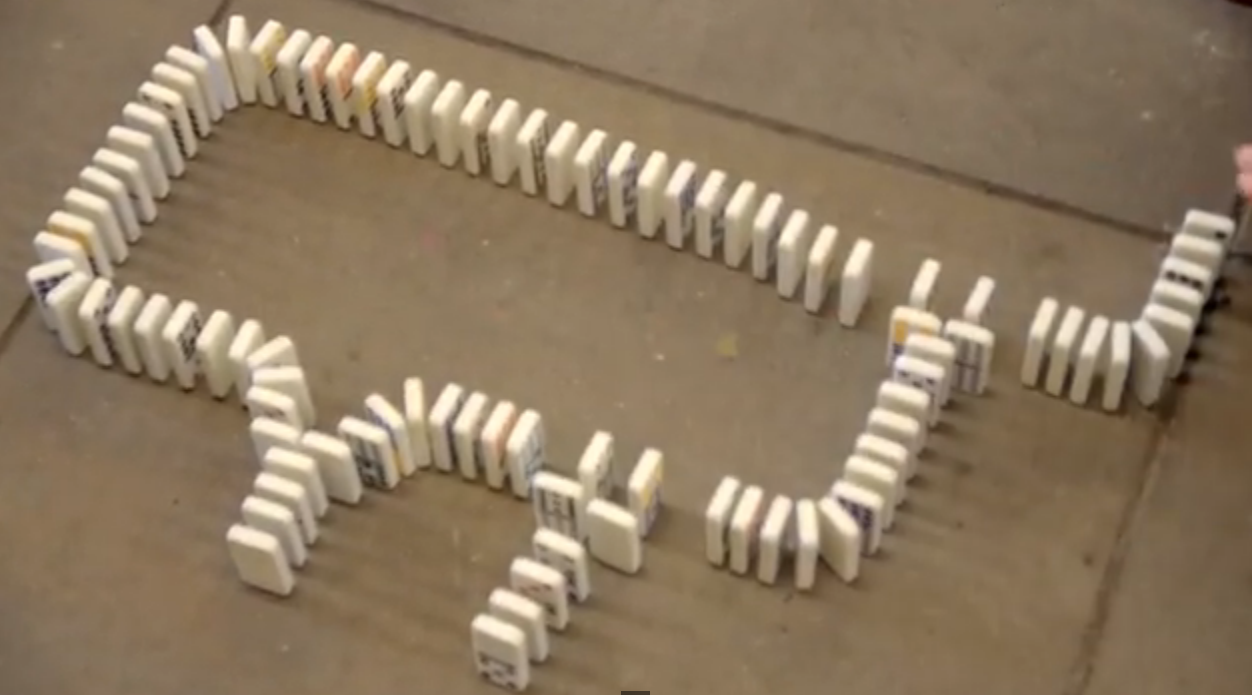A computer made of 10,000 domino bones
Matt Parker, noted in Numberphile and Standup Maths projects, together with the team of Domino Computer Builders, built, probably, the slowest computer in the world from domino bones.
Some details under the cut.
The first thing you need is basic elements. This is what AND gate looks like:

If you push one of the inputs (“send a unit”), we get “zero” at the output: the “unit” on the right input simply “closes the key”, the unit on the left will split, and the signal that went to the right closes the key for the left before he reaches it. If you push both inputs, the right signal, closing the key, will not allow the left input to "self-destruct", and the "unit" will go to the output.
And this is the XOR gate.

Here, if you send “units” to both inputs, the dominoes will stop in the middle and the output will be “zero”.
A half-adder is composed of these two elements, which takes two bits to the input and gives their sum to two outputs: the output of “units” is XOR, the output of “twos” is AND.

The zigzag on the right is the delay of the signal to enable the key to be closed before the deuces exit, if necessary.
The left output is x XOR y - units, the right - (NOT (x XOR y)) AND y = x AND y - two.
From two half-adders, a full-fledged adder is obtained, which, in addition to the input bits, also receives a carry bit. By combining three such adders (and a half adder for the initial bits, where transfer is not required), the team received a calculator that can add two four-bit numbers and give a five-bit answer.
The main problem with such circuits is signal leakage. An improperly falling or flying domino bone can trigger another chain, thus “breaking” the conclusion.
Some details under the cut.
The first thing you need is basic elements. This is what AND gate looks like:

If you push one of the inputs (“send a unit”), we get “zero” at the output: the “unit” on the right input simply “closes the key”, the unit on the left will split, and the signal that went to the right closes the key for the left before he reaches it. If you push both inputs, the right signal, closing the key, will not allow the left input to "self-destruct", and the "unit" will go to the output.
And this is the XOR gate.

Here, if you send “units” to both inputs, the dominoes will stop in the middle and the output will be “zero”.
A half-adder is composed of these two elements, which takes two bits to the input and gives their sum to two outputs: the output of “units” is XOR, the output of “twos” is AND.

The zigzag on the right is the delay of the signal to enable the key to be closed before the deuces exit, if necessary.
The left output is x XOR y - units, the right - (NOT (x XOR y)) AND y = x AND y - two.
From two half-adders, a full-fledged adder is obtained, which, in addition to the input bits, also receives a carry bit. By combining three such adders (and a half adder for the initial bits, where transfer is not required), the team received a calculator that can add two four-bit numbers and give a five-bit answer.
The main problem with such circuits is signal leakage. An improperly falling or flying domino bone can trigger another chain, thus “breaking” the conclusion.
